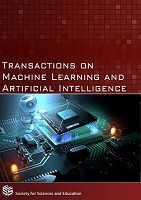Real-Robot Friendly Passing Motion Planner for Autonomous Navigation in Crowds
DOI:
https://doi.org/10.14738/tmlai.101.11616Keywords:
passing motion plan, dynamic environment, mobile robot, deep reinforcement learningAbstract
This study proposes a real‐robot friendly passing motion planner to be used in crowds. The proposed method learns to pass pedestrians with smooth acceleration and deceleration by using passing motion learning. A key feature of the proposed method is that it is trained on a simple crowd simulation with both dynamic and stationary pedestrians. The learned passing behaviour can be used directly in autonomous navigation. Evaluations using the crowd simulations indicate that the proposed method outperforms the existing ones in terms of success rate, arrival time, and keeping a certain distance from the pedestrians. The proposed navigation framework is implemented on a mobile robot and demonstrated its successful navigation between pedestrians in a science museum.
References
. D. Fox, W. Burgard, and S. Thrun, “The dynamic window approach to collision avoidance,” IEEE Robotics & Automation Magazine, vol. 4, no. 1, pp. 23–33, 1997
. S. Quinlan and O. Khatib, “Elastic bands: connecting path planning and control,” in [1993] Proceedings IEEE International Conference on Robotics and Automation, 1993, pp. 802–807 vol.2
. P. Fiorini and Z. Shiller, "Motion planning in dynamic environments using velocity obstacles," The International Journal of Robotics Research, vol. 17, no. 7, pp. 760-772, 1998.J. Van den Berg, M. Lin, and D. Manocha, “Reciprocal velocity obstacles for real-time multi-agent navigation,” in 2008 IEEE International Conference on Robotics and Automation. IEEE, 2008, pp. 1928–1935
. J. Van Den Berg, S. J. Guy, M. Lin, and D. Manocha, “Reciprocal n-body collision avoidance,” in Robotics research. Springer, 2011, pp. 3–19.
. D. Helbing and P. Molnar, “Social force model for pedestrian dynamics,” Physical review E, vol. 51, no. 5, p. 4282, 1995.
. D. Helbing and P. Molnar, “Social force model for pedestrian dynamics,” Physical review E, vol. 51, no. 5, p. 4282, 1995.
. S. Pellegrini, A. Ess, K. Schindler, and L. van Gool, “You’ll never walk alone: Modeling social behavior for multi-target tracking,” in 2009 IEEE 12th International Conference on Com- puter Vision, 2009, pp. 261–268.
. A. Vemula, K. Muelling, and J. Oh, “Modeling cooperative navigation in dense human crowds,” in 2017 IEEE International Conference on Robotics and Automation (ICRA). IEEE, 2017, pp. 1685–1692.
. Z. Chen, C. Song, Y. Yang, B. Zhao, Y. Hu, S. Liu, and J. Zhang, “Robot navigation based on human trajectory prediction and multiple travel modes,” Applied Sciences, vol. 8, no. 11, p. 2205, 2018.
. B. D. Luders, G. S. Aoude, J. M. Joseph, N. Roy, and J. P. How, “Probabilistically safe avoidance of dynamic obstacles with uncertain motion patterns,” Tech. Rep., 2011
. P. Trautman and A. Krause, “Unfreezing the robot: Navigation in dense, interacting crowds,” in 2010 IEEE/RSJ International
. H.-T. L. Chiang, A. Faust, M. Fiser, and A. Francis, “Learning navigation behaviors end-to-end with autorl,” IEEE Robotics and Automation Letters, vol. 4, no. 2, pp. 2007–2014, 2019
. T. Fan, X. Cheng, J. Pan, D. Manocha, and R. Yang, “Crowd- move: Autonomous mapless navigation in crowded scenarios,” arXiv preprint arXiv:1807.07870, 2018.
. M. Pfeiffer, S. Shukla, M. Turchetta, C. Cadena, A. Krause, R. Siegwart, and J. Nieto, “Reinforced imitation: Sample efficient deep reinforcement learning for mapless navigation by leveraging prior demonstrations,” IEEE Robotics and Automation Letters, vol. 3, no. 4, pp. 4423–4430, 2018.
. C. Chen, Y. Liu, S. Kreiss, and A. Alahi, “Crowd-robot interac- tion: Crowd-aware robot navigation with attention-based deep reinforcement learning,” in 2019 International Conference on Robotics and Automation (ICRA), 2019, pp. 6015–6022.
. M. Everett, Y. F. Chen, and J. P. How, “Motion planning among dynamic, decision-making agents with deep reinforcement learn- ing,” in 2018 IEEE/RSJ International Conference on Intelligent Robots and Systems (IROS), 2018, pp. 3052–3059.
. Min Zhou, Hairong Dong, Fei-Yue Wang, Qianling Wang, Xiaoxia Yang, Modeling and simulation of pedestrian dynamical behavior based on a fuzzy logic approach, Information Sciences, Vol. 360, 2016, pp. 112-130.
. V. Mnih, A. P. Badia, M. Mirza, A. Graves, T. Harley, T. P. Lillicrap, D. Silver, and K. Kavukcuoglu, “Asynchronous meth- ods for deep reinforcement learning,” in Proceedings of the 33rd International Conference on International Conference on Machine Learning - Volume 48, ser. ICML’16. JMLR.org, 2016, p. 1928–1937.
. A. Kanezaki, J. Nitta, and Y. Sasaki, “Goselo: Goal-directed obstacle and self-location map for robot navigation using reactive neural networks,” IEEE Robotics and Automation Letters, vol. 3, no. 2, pp. 696–703, 2018
. A. Krizhevsky, I. Sutskever, and G. Hinton, “Imagenet classifi- cation with deep convolutional neural networks,” Neural Infor- mation Processing Systems, vol. 25, 01 2012.
. Y. Fujita, P. Nagarajan, T. Kataoka, and T. Ishikawa, “Chainerrl: A deep reinforcement learning library,” Journal of Machine Learning Research, vol. 22, no. 77, pp. 1–14, 2021.
. N. Koenig and A. Howard, “Design and use paradigms for gazebo, an open-source multi-robot simulator,” in IEEE/RSJ International Conference on Intelligent Robots and Systems, Sendai, Japan, Sep 2004, pp. 2149–2154.
. A. Ohsato, Y. Sasaki, and H. Mizoguchi, “Real-time 6Dof localization for a mobile robot using pre-computed 3D laser likelihood field,” in 2015 IEEE International Conference on Robotics and Biomimetics (ROBIO 2015), China, 2015, pp. 2359–2364.
. N. Hatao and S. Kagami, “Cluster-based sjpdafs for classification and tracking of multiple moving objects,” in Field and Service Robotics. Springer, 2015, pp. 303–317.
Downloads
Published
How to Cite
Issue
Section
License
Copyright (c) 2022 Shun Niijima, Yoko Sasaki, Hiroshi Mizoguchi

This work is licensed under a Creative Commons Attribution 4.0 International License.






